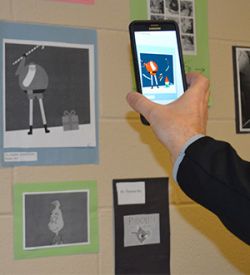There’s more than meets the eye in teacher Greg Reinstein’s classroom. Known as “Stein’s World,” the class appears artsy and tech-y all at once, but, really, that’s the least of it. Computer coding has taken on a life of its own.
Hanging on a wall in the Byron Center High School classroom are paper images of a Slinky toy, a Christmas tree, the Grinch, a soccer ball, and faces of celebrities and politicians. But if you scan them with a smart phone or tablet using an app called Aurasma, the pictures come to life on screen.
The Slinky crawls, a “How to Draw a Christmas Tree” tutorial begins, the face of a controversial politician becomes something else entirely.
It’s Reinstein’s pilot Web and Mobile App Development class, and students are using a new art form that combines traditional art with digital art from the cloud, software and services that run on the Internet. The mind-boggling, emerging “augmented reality” technology scans trigger images, which ignite more images on screen. Soon, the high school yearbook will contain the hidden images and messages, he said.
“We can interact now with billboards and print,” Reinstein said.
Students, busy working on various projects and learning coding, are breaking through old boundaries in technology by embedding AR into everyday art. It has caught the attention of students who have an interest in everything from math to animation, science to cybersecurity.
“I’m amazed at how many different opportunities and creative things you can make with it,” said senior Hugh Thiel. “There are so many different things you can create with coding and projects like (AR) and websites. The possibilities are really endless.”

Language of the Future
Reinstein, a 23-year Byron Center teacher and longtime proponent of technology in education, teaches several classes in the school’s visual arts department, including Animation and Game Design, Photography, Computer Graphics and traditional art classes. He is an adjunct professor for Kendall College of Art & Design dual-enrollment classes. His classes put modern twists on classic video games, create detailed graphics and animation, apps and personalized web sites.
“I don’t think we as humans know the potential of augmented reality,” Reinstein said, adding that it’s fun to watch it unfold. With more student direction in class and more tech tools available, students are embracing challenges.
Senior Trevor Hofman created a jack-in-the box image that opens when scanned using AR.
“This class is like no other class I’ve been in before,” said Trevor, who hopes to become a computer engineer. “It lets you learn a skill that’s applicable to things other than academics. Once you learn coding, you can use it for anything from writing your own scripts on your own computer to using it to write a code to help you with your homework.”
Reinstein said coding should be a focus of school like foreign language is, teaching students the language of computer so they can use it throughout their lives.
“It’s nice to see the students having the experience at this level,” he said. “They are more directed and thinking about what they want to do in college. We talk a lot about 21st century skill sets, and we make a lot of connections to career pathways in IT and computer science.”
Senior Tim Irish said learning the programming now is helping him build a valuable foundation.
“It’s cutting edge,” Tim said. “It’s exciting. It can evolve into a profitable lT career. All these skills can be used in every career.”
CONNECT









